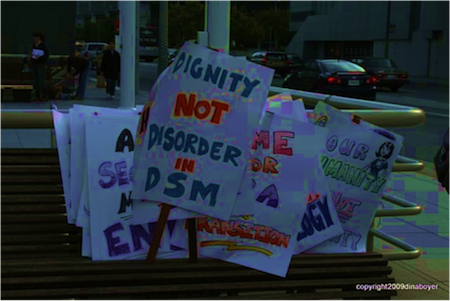This piece is a revised version of two articles originally posted on my blog (juliaserano.blogspot.com) on December 3 and 4, 2012.
On the morning of December 3, 2012, I woke up to find my Twitter feed full of article links celebrating that in the next edition of the DSM the diagnosis “Gender Identity Disorder” (GID) would be changed to “Gender Dysphoria.” Many in the trans community were excited because the change in name seemed to mean that transgender people would no longer be described by the DSM as “disordered.” The problem is that this is absolutely untrue. Trans people are still “disordered” according to the DSM5.
The confusion results in part from the trans community’s near-exclusive focus on GID—understandable given that GID is the diagnosis trans people are required to obtain if we wish to access the means to physical and/or legal transition, and given that GID has been used to justify horrible reparative therapies against gender-nonconforming children. But in focusing on GID, the trans community gave short shrift to the other currently existing DSM diagnosis that also affects us: Transvestic Fetishism. Back in 2008, when most trans people were looking only at GID, I was paying close attention to the DSM section on Paraphilias (or “Sexual Deviation,” as it was termed in the first two editions of the manual), the DSM category into which Transvestic Fetishism falls. The Paraphilias section lists several sexual crimes (such as pedophilia, frotteurism, and exhibitionism) along with a handful of other consensual sexual acts (including fetishism and BDSM) that are considered pathologies by some psychiatrists. Transvestic Fetishism, which has historically targeted heterosexual men who experience sexual arousal from cross-dressing, has long been categorized as a paraphilia.
When Ray Blanchard was named Chair of the DSM Paraphilas subworkgroup, I knew that we were in trouble. I sometimes joke that Blanchard is my arch nemesis. (After all, every trans narrative needs an arch nemesis!) Much of his career has been spent psychiatrically sexualizing trans female/feminine-spectrum people, most notably via his theory of autogynephilia. I have given detailed explanations of autogynephilia theory elsewhere. In a nutshell, this theory conflates most trans women with male cross-dressers and claims that our gender expressions, transitions to female, and identities are sexually motivated. This runs counter to our own personal experiences and reinforces stereotypes of trans woman as hypersexual and deceptive.
Because I was already acquainted with Blanchard’s work, I feared that he might try to expand the Transvestic Fetishism diagnosis. He did not disappoint. As I outlined in a 2009 article, Blanchard sought to expand both the DSM definition of “Paraphilia” and the Transvestic Fetishism diagnosis. He renamed this newly expanded diagnosis “Transvestic Disorder.” As I pointed out in my keynote for the 2009 Philadelphia Trans Health Conference:
While [Transvestic Disorder] supposedly targets “heterosexual males” who crossdress, the psychological literature regarding autogynephilia (the bulk of it written by Blanchard) repeatedly claims that lesbian, bisexual, and asexual trans women are really just heterosexual men with a fantasy problem. Therefore, according to Blanchard’s proposal, a queer-identified trans woman (such as myself) could theoretically be diagnosed as having “Transvestic Disorder” any time that I have any kind of sexual urge while wearing women’s clothing. Since I wear women’s clothing pretty much every day of my life these days, my sexuality would presumably be considered perpetually transvestically disordered according to this diagnosis.
I spent a long time trying to raise awareness of the Transvestic Disorder diagnosis when it was first proposed. So did a few other trans activists and advocates, most notably Kelley Winters. But for the most part, the trans community ignored the proposed diagnosis, probably because at this stage it seemed not to apply to trans male/masculine folks, or to heterosexual-identified trans women. Because the community at large did not appear to be concerned about Transvestic Disorder, I stopped writing about it.
The following year, in May 2010—after the formal period of comments had passed—the DSM quietly broadened the language of the Transvestic Disorder diagnosis even more. One of the many complaints that I, and other trans advocates and activists, had raised was that the diagnosis was sexist because it singled out “heterosexual males.” We had levied these critiques in order to push for removal of the diagnosis altogether. But Blanchard and his Paraphilia subworkgroup seemed to have used our complaints as an excuse to expand the diagnosis even further! By removing the “heterosexual male” language, they made Transvestic Disorder applicable to trans people of all identities and sexual orientations.
While one might argue that the Gender Dysphoria diagnosis at least provides some benefit for trans people (since it allows those who have adequate health insurance to access trans-related health care), Transvestic Disorder has absolutely no benefit whatsoever. All it does is provide additional stigma.
And this stigma will profoundly affect the lives of many trans people, even those who are never formally diagnosed with Transvestic Disorder. A large body of evidence has shown that when a person is reduced to their sexual bodies and behaviors, rather than viewed as a whole person, most people tend to dehumanize them. And that’s why the newly expanded Transvestic Disorder has the potential to do even more harm than the Gender Dysphoria diagnosis: While both portray gender variance as mental disorders, Transvestic Disorder depicts trans people as being both mentally ill and sexually deviant.
The vast majority of violence perpetrated against transgender people targets trans women and others on the trans feminine spectrum, often under the pretense that we are sexually deceptive, promiscuous, and/or predators. And trans women of color are twice as likely as their white counterparts to be murdered in such hate crimes. Transvestic Disorder perpetuates this societal sexualization of trans women and extends it to trans male/masculine people. As such, it will no doubt be cited in court cases and by conservative political forces in their attempts to further invalidate trans people’s gender identities and undermine anti-trans-discrimination laws.


